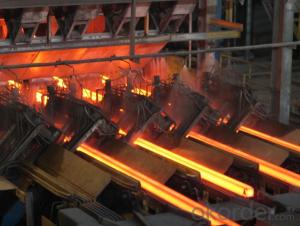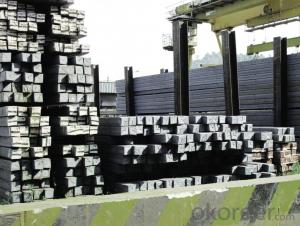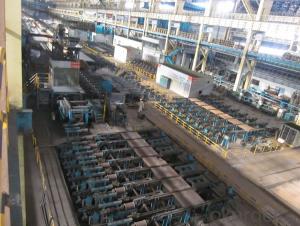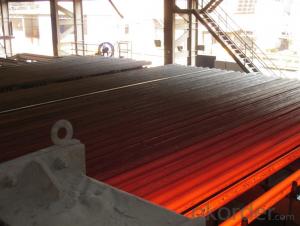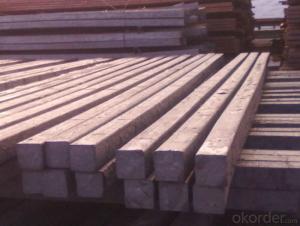Prime Q275 105mm Square Alloy Steel Billet
- Loading Port:
- Shanghai
- Payment Terms:
- TT OR LC
- Min Order Qty:
- 100 m.t.
- Supply Capability:
- 10000 m.t./month
OKorder Service Pledge
OKorder Financial Service
You Might Also Like
Structure of Prime Q275 105mm Square Alloy Steel Billet

Description of Prime Q275 105mm Square Alloy Steel Billet
1. Prepainted steel coil is coated with organic layer, which provides higher anti-corrosion property and a longer lifespan than that of galvanized or galvalume steel sheets.
2. The base metals for prepainted steel coil consist of cold rolled, HDGI Steel, electro-galvanized and hot-dip alu-zinc coated steel. The finish coats of prepainted steel coil can be classified into groups as follows: polyester, silicon modified polyesters, polyvinylidene fluoride, high-durability polyester, etc.
3. The production process has evolved from one-coating-and-one-baking to double-coating-and-double-baking, and even three-coating-and-three-baking.
4. The color of the prepainted steel coil has a very wide selection, like orange, cream-colored, dark sky blue, sea blue, bright red, brick red, ivory white, porcelain blue, etc.
5. The prepainted steel coils can also be classified into groups by their surface textures, namely regular prepainted sheets, embossed sheets and printed sheets.

Main Feature of Prime Q275 105mm Square Alloy Steel Billet
Uncoated CR steel sheet
With the features of in line with the international highest standards in demension and shape, excellent surface finish and properties, the products are mainly used in home appliance and automobile industries.
Galvanized steel sheet(include HDG and EG)
With the features of good corrosion resistance, the products are mainly used in automobile, home appliance, electronics, building and machinery manufacture industries, etc.
Precoated steel sheet
With the features of enviromental protection and good processablility, long lasting surface durability, rich in colors, the products are maily used in building, home appliance and furniture industries, etc.
Applications of Prime Q275 105mm Square Alloy Steel Billet
A. Corrugated design makes it excellent waterproof performance
B. Materials as prepainted steel sheets, galvanized steel sheets, galvalume (Al-Zn coated sheets) are available to make corrugated sheet.
C.Those material are durable, anti-corrosion in bad weather for 20-30 years based on it's Zinc(Galvanized) coating or AZ (Galvalume) coating.
D. Different shape of the sheet make it suitable for any style of buildings.
E.Easy to install, no need special tools to fix the sheet.
F.Light weight due to high strength to weight ratio of steel. Light weight means easier handling lower shipping costs, easier installation
G. Different color is availbe base on the RAL Standard make your building more beautiful.
H. We will provide the best solutions if you don't have a exact idea of the specification you want for the steel sheet based on your weather conditions, engineering structure, construction budget and so on.

Specifications of Prime Q275 105mm Square Alloy Steel Billet
Product | Billet |
Material Grade | SGCC / SGCH / DX51D+AZ, etc |
Thickness | 0.6-3.0mm |
Width | 500-1500mm |
Tolerance | Thickness: +/-0.02mm , Width:+/-2mm |
Zinc-coating | Z30-150g/m2 |
Technique | Raw material: Hot rolled steel coil --> Cold rolled_>hot dipped galvalume |
Surface | Dried, Chromated, Unoiled |
Spangle | Regular spangle , small spangle, zero spangle |
ID | 508MM 610MM |
Coil weight | 1-25MT |
Export package | Cardboard inner sleeves, Waterproof paper, galvanized steel covered and steel strip packed |
FAQ of Prime Q275 105mm Square Alloy Steel Billet
We have organized several common questions for our clients,may help you sincerely:
1. How Can I Visit There?
Our company is located in Tianjin City, China, near Beijing. You can fly to Tianjin Airport Directly. All our clients, from home or aboard, are warmly welcome to visit us!
2. How Can I Get Some Sample?
We are honored to offer you sample.
3. Why choose CNBM?
Our delivery time about 15-20days for standard sizes, if you have other requirements like hardness, quanity and width ,it is about 20-40days. But don't worry we also try our best for the delivery time ,because time longer and our cost is higher.
- Q:How are steel billets inspected for quality?
- Steel billets are typically inspected for quality using various non-destructive testing methods such as visual inspection, ultrasonic testing, magnetic particle inspection, and dye penetrant testing. These tests help identify any surface defects, cracks, or internal flaws in the billets, ensuring that they meet the required quality standards before further processing.
- Q:How many tons of billets does it take to produce a ton of thread steel?
- Domestic steel manufacturers, production rate of about 97%, so probably need 1/97%=1.03 tons. The yield was increased, consumption will be reduced.
- Q:What are the different types of defects found in steel billets?
- There are several types of defects that can be found in steel billets. Some common ones include surface defects like cracks, scars, and scale; internal defects like inclusions, segregations, and voids; and dimensional defects such as uneven size or shape. These defects can affect the quality and strength of the steel, so it is important to identify and address them during the manufacturing process.
- Q:Are steel billets used in the production of household goods?
- No, steel billets are typically not used in the production of household goods. They are usually used as raw materials in steel mills for the production of various steel products, such as bars, rods, pipes, and structural components.
- Q:How are steel billets inspected for chemical composition?
- Steel billets are inspected for chemical composition through a process called chemical analysis. This involves taking a sample from the billet and subjecting it to different testing methods to determine the precise amounts of various elements present in the steel. One common method used is spectrometry, specifically optical emission spectrometry (OES) or inductively coupled plasma (ICP) spectrometry. These techniques involve heating the steel sample until it reaches a plasma state, which allows the individual elements to emit characteristic wavelengths of light. By analyzing the emitted light, the concentration of each element can be determined. Another method is X-ray fluorescence (XRF) analysis. This technique involves bombarding the steel sample with high-energy X-rays, which causes the atoms in the sample to emit secondary X-rays. By measuring the energy and intensity of these secondary X-rays, the composition of the steel can be determined. In addition to these methods, other techniques such as mass spectrometry and wet chemical analysis may also be employed, depending on the specific requirements and accuracy needed for the inspection. Overall, steel billets are inspected for chemical composition using a combination of sophisticated analytical techniques, ensuring that the steel meets the desired specifications and quality standards.
- Q:How are steel billets used in the manufacturing of railway equipment?
- Steel billets are used in the manufacturing of railway equipment as they are heated and then shaped into various components such as rails, wheels, axles, and couplings. These billets serve as the raw material that undergoes further processing, including cutting, bending, and welding, to create the final products used in the construction and maintenance of railway systems.
- Q:What are the different types of surface coating methods used for steel billets?
- There are several types of surface coating methods used for steel billets, including galvanizing, electroplating, powder coating, and painting. Galvanizing involves applying a layer of zinc to the surface of the billets to provide corrosion resistance. Electroplating uses an electrical current to deposit a thin layer of metal onto the steel surface, enhancing its appearance and protecting it from corrosion. Powder coating involves applying a dry powder to the billets, which is then heated to form a protective layer. Painting is another common method, where a liquid paint is applied to the billets to provide both protection and aesthetic appeal.
- Q:What are the potential applications of steel billets in the medical aftermarket?
- Steel billets have potential applications in the medical aftermarket for the manufacturing of surgical instruments, orthopedic implants, and medical equipment components. The high strength, durability, and corrosion resistance of steel make it suitable for these applications, ensuring reliable and long-lasting medical devices. Additionally, steel billets can be customized and shaped to meet specific requirements, allowing for the production of complex and intricate medical instruments and implants.
- Q:What is the role of steel billets in the construction of commercial buildings?
- Steel billets play a crucial role in the construction of commercial buildings as they serve as the raw material for various structural elements. These billets are heated and then shaped into different forms, such as beams, columns, and bars, which provide the necessary strength and stability to support the weight of the building. Additionally, steel billets are often used to create reinforcements within concrete structures, enhancing their durability and resistance to external forces. Overall, steel billets are essential for creating the skeletal framework of commercial buildings, ensuring their structural integrity and safety.
- Q:What are the main factors affecting the cost of steel billets?
- The cost of steel billets can be influenced by several key factors. 1. Raw material expenses play a significant role in determining the overall cost of steel billets. The prices of iron ore and scrap metal, which are used in the production process, can fluctuate in the global market, causing the cost of steel billets to rise or fall. 2. The cost of manufacturing steel billets includes various production and processing costs. These expenses, such as energy, labor, and maintenance costs, can vary depending on factors like production efficiency, skilled labor availability, and energy source prices. 3. The balance between supply and demand in the steel billet market can heavily impact their cost. If there is high demand and limited supply, prices can increase. Conversely, if there is excess supply and low demand, prices can decrease. 4. The level of competition among steel producers can also affect the cost of steel billets. In a competitive market, prices may be driven down as producers vie for customers. In a less competitive market, producers may have more pricing power, leading to higher prices. 5. Government policies and trade barriers, such as import tariffs and quotas, can influence the cost of steel billets. These measures can either protect domestic producers or create opportunities for cheaper imports, depending on specific policies in place. 6. Fluctuations in currency exchange rates can impact the cost of steel billets. A stronger domestic currency can make imported steel billets cheaper, while a weaker currency can make them more expensive. 7. The cost of transporting steel billets from production facilities to end-users can also affect their overall cost. Factors like distance, transportation mode, and fuel prices can impact transportation expenses, which can, in turn, affect the final price of steel billets. It is important to consider that these factors can interact with each other and their impact on the cost of steel billets can vary based on market conditions and industry dynamics.
1. Manufacturer Overview |
|
|---|---|
| Location | |
| Year Established | |
| Annual Output Value | |
| Main Markets | |
| Company Certifications | |
2. Manufacturer Certificates |
|
|---|---|
| a) Certification Name | |
| Range | |
| Reference | |
| Validity Period | |
3. Manufacturer Capability |
|
|---|---|
| a)Trade Capacity | |
| Nearest Port | |
| Export Percentage | |
| No.of Employees in Trade Department | |
| Language Spoken: | |
| b)Factory Information | |
| Factory Size: | |
| No. of Production Lines | |
| Contract Manufacturing | |
| Product Price Range | |
Send your message to us
Prime Q275 105mm Square Alloy Steel Billet
- Loading Port:
- Shanghai
- Payment Terms:
- TT OR LC
- Min Order Qty:
- 100 m.t.
- Supply Capability:
- 10000 m.t./month
OKorder Service Pledge
OKorder Financial Service
Similar products
New products
Hot products
Related keywords
